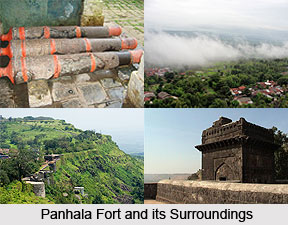 History of Panhala is closely associated with the history of the glorious Maratha Empire. The Maratha Empire and its founder Shivaji played an important role in giving a secured position.
History of Panhala is closely associated with the history of the glorious Maratha Empire. The Maratha Empire and its founder Shivaji played an important role in giving a secured position.
Panhala is the only medieval fort where Shivaji spent more than 500 days, other than his childhood homes. It was State Capital of Maratha until 1782 and in the year 1827 it became part of the British Empire in India.
This imposing fort of medieval Maharashtra, Panhala Fort is just 20 km northwest of Kolhapur, built on an outlying spur of the Sahyadri Mountain Range, rising more than 400 metres above plain, and is the largest of all the Deccan forts.
The strategic importance of Panhala Fort is guarding one of the principal routes through the Western Ghats Mountain Range in India. It can be judged from its long and varied history.
Panhala Fort was built between 1178 and 1209. Panhala Fort first served as the headquarters of the Shilahara ruler Bhoja II, and subsequently passed into hands of the Yadavas.
It was a favourite outpost of the Bahamanis of Bidar; Mahmud Gawan, the powerful Prime Minister of Shivaji times, encamped here during the rainy season of 1469. By the beginning of the 16th century, Panhala was absorbed into the kingdom of Bijapur or Bijapur Sultanate.
The Adil Shahis were responsible for strengthening and rebuilding the ramparts and gateways. Panhala Fort was raided by Shivaji in 1659, but it was not until 1673 that he was able to occupy it permanently.
After the death of Shambaji in 1689, Panhala Fort was captured by Aurangzeb, the last ruler of Mughal Dynasty. However, it was re-captured in 1692 by Kashi Ranganath Sarpotdar under the guidance of Parshuram Pant Pratinidhi. In the year 1701, Panhala was finally surrendered to Aurangzeb, and it was here that the Mughal Emperor received the English Ambassador, Sir William Norris. Within a few months Panhala Fort was retaken by the Maratha forces under Pant Amatya Ramachandra.
Tarabai asserted her autonomy by founding an independent dynasty. In the year 1782, the rulers shifted their headquarters to Kolhapur. After a local rebellion in 1844, Panhala was taken by the British East India Company. More than 7 kilometres of fortifications define the approximately triangular zone of Panhala fort. The walls of Panhala Fort are protected for long sections by steep escarpments, reinforced by a parapet with slit holes. The remaining sections have 5 to 9 metres high ramparts, strengthened by round bastions. Unfortunately, the East Gate called Char Darawaja, through which the road passes on arrival at fort, was demolished by the British East India Company.
Panhala fort has another satellite fort visible. It is said that there were wells full with Ghee to cure the soldiers. The well-known poet Kavi Moropant stayed here for some times. There are the nearby tourist spots which are of worth importance like Sambhaji temple, Someshwar temple, Teen Darwaza, and Raj Dindi. Sajja Kothi. Ambabai Temple is the temple where Shivaji used to seek blessings before venturing on expeditions. Pavankhind is the place where Baji Prabhu Deshpande laid down his life to cover escape of Shivaji from Mughal tyranny.



















